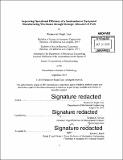| dc.contributor.advisor | Stephen C. Graves. | en_US |
| dc.contributor.author | Toor, Paramveer Singh | en_US |
| dc.contributor.other | Massachusetts Institute of Technology. Department of Mechanical Engineering. | en_US |
| dc.date.accessioned | 2016-03-03T21:03:38Z | |
| dc.date.available | 2016-03-03T21:03:38Z | |
| dc.date.copyright | 2015 | en_US |
| dc.date.issued | 2015 | en_US |
| dc.identifier.uri | http://hdl.handle.net/1721.1/101477 | |
| dc.description | Thesis: M. Eng. in Manufacturing, Massachusetts Institute of Technology, Department of Mechanical Engineering, 2015. | en_US |
| dc.description | Cataloged from PDF version of thesis. | en_US |
| dc.description | Includes bibliographical references (page 75). | en_US |
| dc.description.abstract | The work addresses the operational inefficiency problem in a semiconductor equipment manufacturing warehouse of Applied Material's Varian Semiconductor Business Unit. At Varian, the target part delivery time from the warehouse to the production floor is 24 hours. However, during busy periods, parts are not delivered on time. Late part delivery from the warehouse to the production floor could delay the machine laydown date, which in turn could result in late or missed shipment of tools to the customers, which can be very costly. To improve the efficiency and the reliability of the warehouse, picking efficiency is to be improved. Parts from the warehouse are picked from three picking locations- Vertical Lift Modules (VLMs), GL, and RK. VLMs are automated machines, while GL and RK are manual picking zones. Picking an order from GL takes the most amount of time. The overall picking efficiency at the warehouse can be improved by partially shifting the workload from GL to the VLMs, and by further improving the picking efficiency at the VLMs. The workload from GL to the VLMs is shifted by transferring fast moving parts from GL to the VLMs. The picking efficiency of the VLMs is improved by balancing the workload of all five VLM pods, and by employing a more efficient 'pick-and-consolidate' picking strategy. The workload at GL is decreased by 25% and the workload at VLMs is increased by 13%. Despite the increase in workload at VLMs, 23% time savings could be achieved by balancing the utilization of all five VLM pods. Additional time savings of 20 minutes per order (8%) could be achieved by using 'pick-and-consolidate' picking strategy over 'pick-and-pass' picking strategy. | en_US |
| dc.description.statementofresponsibility | by Paramveer Singh Toor. | en_US |
| dc.format.extent | 75 pages | en_US |
| dc.language.iso | eng | en_US |
| dc.publisher | Massachusetts Institute of Technology | en_US |
| dc.rights | M.I.T. theses are protected by copyright. They may be viewed from this source for any purpose, but reproduction or distribution in any format is prohibited without written permission. See provided URL for inquiries about permission. | en_US |
| dc.rights.uri | http://dspace.mit.edu/handle/1721.1/7582 | en_US |
| dc.subject | Mechanical Engineering. | en_US |
| dc.title | Improving operational efficiency of a semiconductor equipment manufacturing warehouse through strategic allocation of parts | en_US |
| dc.type | Thesis | en_US |
| dc.description.degree | M. Eng. in Manufacturing | en_US |
| dc.contributor.department | Massachusetts Institute of Technology. Department of Mechanical Engineering | |
| dc.identifier.oclc | 935343894 | en_US |
